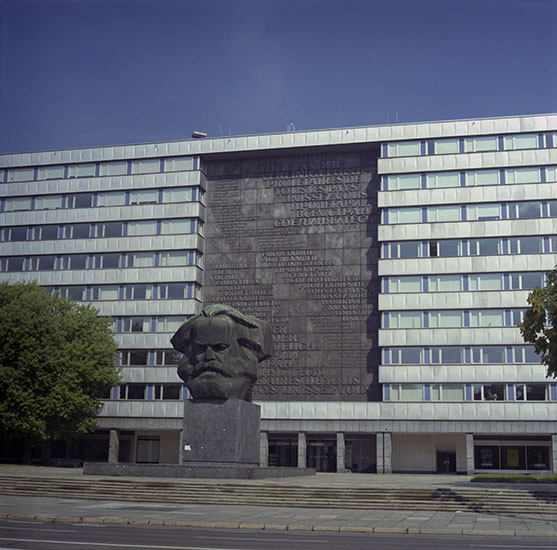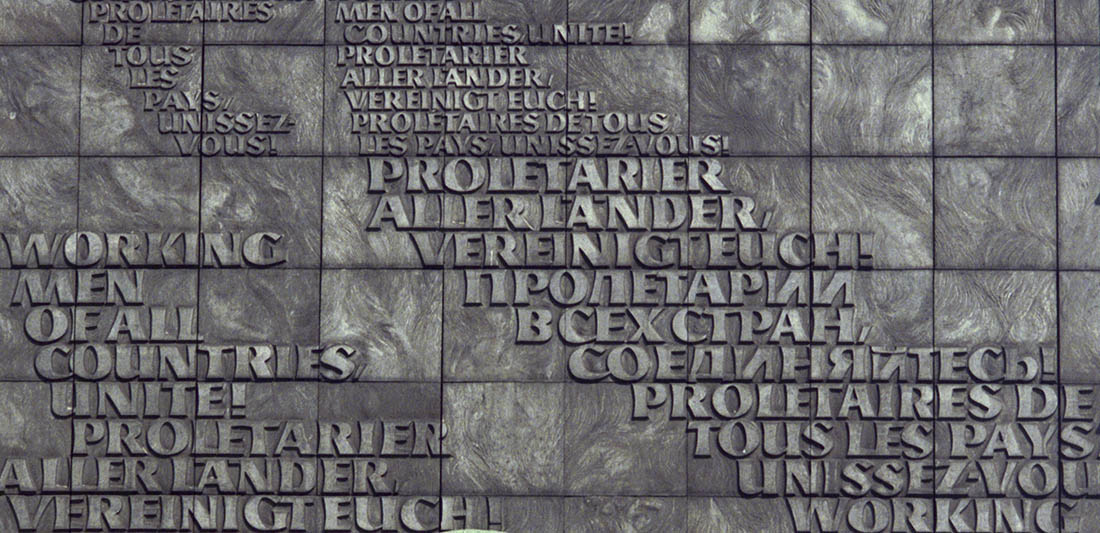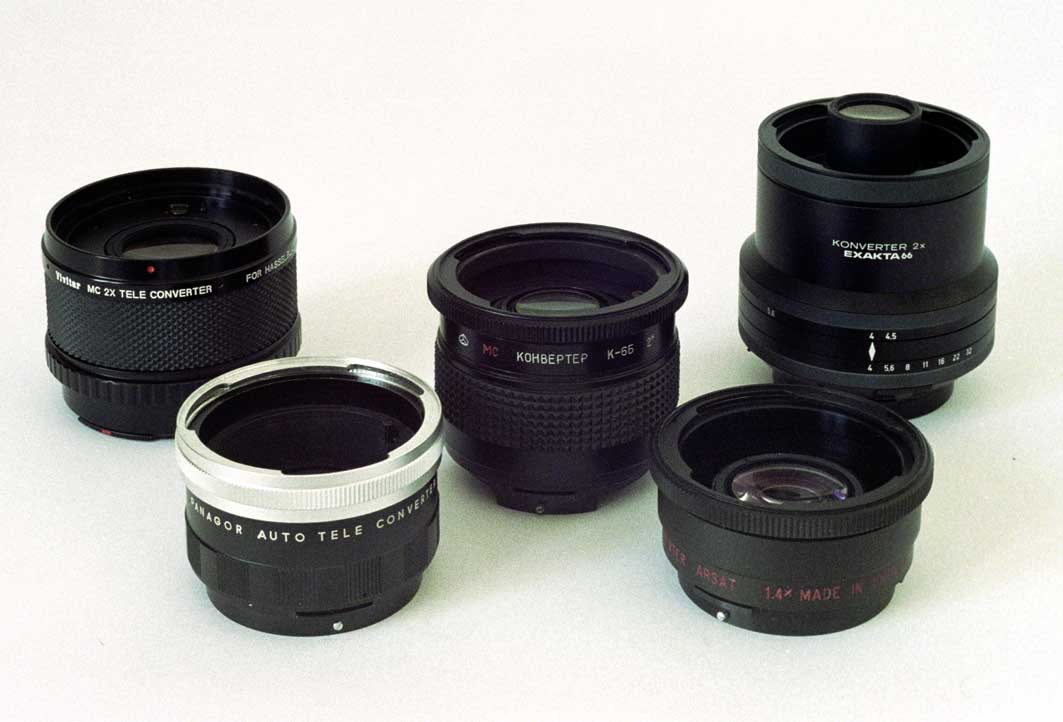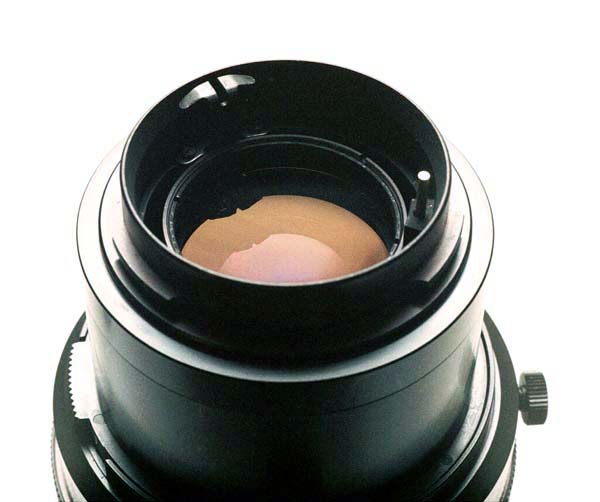Medium Format
Lenses with the Pentacon Six Mount
A comparative test
by TRA
The
teleconverters
A teleconverter dramatically changes the angle of view of any
lenses with which it is used. Carrying a relatively small
converter can reduce the need to have a large, heavy and often
expensive long lens in the camera bag. Here is an example
of a typical effect.
These two photographs show the
statue to Carl Marx that was controversially erected by the
East German communist dictatorship in the centre of the city
of Chemnitz, which they re-named “Karl Marz Stadt”
in 1953. Chemnitz is in the state of Saxony, which
became part of the Soviet-occupied zone of Germany in
1945. This zone subsequently designated itself as the
“Deutsche Demokratische Republik”, or “German Democratic
Republic” in English. According to Wikipedia (here,
consulted on 15th August 2017), “On April 23, 1990, a
referendum on the future name of the city was held: 76% of
the voters voted for the old name "Chemnitz". On 1 June
1990, the city was officially renamed.”
|
|

80mm Biometar at f/19, 1/250 sec hand-held
The composition of this picture would be improved by a
horizontal crop, removing part of the street and also a
section of the sky. However, to show the difference
between not using and using a 2× converter, I show here the
whole of the image recorded on the film.
[C548_12.jpg]
|
|

80mm Biometar at f/8 + Arsat 2× converter, 1/250 sec
hand-held
Note that I have opened up the lens aperture to compensate
for the converter (see below). Two extra stops are
required with a 2× converter. Here I have opened up by
2½ stops, having re-metered the subject.
[C548_13.jpg]
|
|
These two photographs were taken
within a few minutes of each other, both of them at the
virtually same distance from the statue, using a Pentacon
Six TL loaded with Fuji PRO400H film. A wide and busy
road was between me and the statue, and while I could have
crossed the road to get nearer to it, this would have
resulted in a much less desirable angle of view, as I would
have needed to point the camera upwards at quite an acute
angle, resulting in a less satisfactory view of the face of
Karl Marx, as well as causing considerable “keystone”
distortion to the image of the building behind it. I
had not taken a long lens with me, so the converter enabled
me to “bridge the gap” and get a tighter view of the subject
– one of the common advantages of using a teleconverter.
There is still some “keystoning”, but to avoid it, I would
at least have needed to carry a stepladder with me, or
perhaps to have taken the photograph from a first (US:
“second”) or second (US: “third”) storey window in the
building behind me. Such options may (sometimes!) be
available to professional or official photographers, but on
this website I aim to show what an amateur can achieve with
a Pentacon Six outfit.
A close crop of a section of the text (a famous quotation
from Marx) reveals that the Arsat 2× converter has not
resulted in any observable loss of sharpness.
 [C548_13c.jpg]
[C548_13c.jpg]
|
Teleconverters available for the
Pentacon Six
There are at least three 2× teleconverters in the Pentacon Six
mount:
- A converter manufactured by Panagor in Japan in the 1970s
- A converter manufactured by Arsenal in Kiev, Ukraine
- A converter manufactured by Joseph Schneider of Bad
Kreuznach, Germany
For details of the Schneider-Kreuznach converter, see here and here.
Other 2× converters
There are some other teleconverters with the Pentacon Six mount, but
these appear to be variants of the top two converters listed above.
- “Tiger” appears to be a name under which the Panagor
was marketed in some countries, including the USA.
- a 2× converter labelled “WEP AUTO KINOTELEX 2×” is
sometimes seen on eBay. This looks identical to my Panagor
Auto Tele Converter. This name appears to have been used
principally by a distributor in Germany.
- a 2× converter labelled “Hartblei” is occasionally
seen. There is conficting information on who or what “Hartblei”
is or was, but all their lenses, including the 2× converter,
apparently use exactly the same optical components as the
corresponding Arsenal products. They include two
improvements:
1) they all seem to have an improved multi-coating;
2) they have much better quality control, which reduces the
chances of a faulty product leaving the manufacturers.
They also have different external cosmetic appearance.
Whether or not this is an improvement is a matter of personal
taste, but most people who have expressed an opinion seem to view
it as an improvement.
For this website I have compared the Panagor, Arsenal and
Schneider-Kreuznach 2× teleconverters with each other and with a 2×
teleconverter from Vivitar that was manufactured with the Hasselblad
mount. The 2× Kiev converter is much sharper than the
Panagor. The Schneider 2× converter is better still, on a par with
the Vivitar 2× converter in Hasselblad mount, or perhaps even better
than it.

[C372-26A: three 2× converters with Pentacon Six / Exakta 66 /
Kiev 60 mount, plus a Vivitar for the Hasselblad 500C
Front right is the Arsenal 1.4× converter]
The Vivitar 2× converter for the Hasselblad stands out
immediately as being much bigger and heavier than the other
converters (even though it is not as long as the Schneider
converter for the Exakta 66).
For a report on the remarkable Kilfitt Multi-Kilar 2× – 4×
variable teleconverter, see here.
Report on the
Hartblei 2× converter
You can see a report on the Hartblei 2× converter here.
Incompatibility
limitations with the joseph Schneider 2× converter
It is the shape of the Schneider 2× converter that is most
different from all other converters with the Pentacon Six mount.
As with the Carl Zeiss Oberkochen 2× converter for the Hasselblad
(not reviewed on this website), the front element of the Schneider
converter is mounted at the end of a narrow tube a long way
forward of the front mount of the converter. This means that it
protrudes into the back of the lenses with which it is used,
resulting in some compatibility problems. Although the Exakta 66
manual says that the 2× converter can be used with the 80mm lens,
this is not the case. (I am sure that the manual was written
before the converter was manufactured.) As later Exakta 66
literature states, the Schneider 2× converter can be used with
(Schneider) lenses from 150mm on up. It can be used with very few
Carl Zeiss Jena or Arsenal lenses, as they mostly have a rear
element that is right at the back of the lens – although it works
well with the Pentacon 500mm lens – see the section on 1000mm.

Close-up of the rear of the Carl Zeiss Jena 300mm f/4
Sonnar lens.
The rearmost element of this lens is only just below the mount,
and the Joseph Schneider 2× converter cannot therefore be
mounted on this lens.
The fork-shaped connector at 11 o’clock in this view engages
with a pin in the Pentacon 35mm adapter,
transmitting the aperture selected on the lens via the EDC
contacts on the adapter to the metering circuits in Praktica
LLC, PLC and VLC cameras.
[C308-17]
Close focus and
converters
Converters do not reduce the minimum focussing distance of a
lens, but they don’t increase it either! The
result is that with a 2× converter, you get the same image as if
you had been able to get twice as close! For
example:
- the closest focus of the 80mm Biometar lens is 1 meter
- the closest focus of the 180mm Sonnar lens is 1.7 meters
- even though the focal length of the 80mm Biometar lens + a 2×
converter is now 160mm, the closest focus is still 1
meter!*
* I am indebted to Bob for improving on my
wording here. He points out that "The closest focus to
the end of the lens (the working distance) is
unaffected by a converter." However, he goes on to
say, "The 'minimum focusing distance' is measured
from the image plane (film or sensor) to the subject.
This dimension actually increases by the physical length of
the converter .... the subject to lens distance remaining
the same and hence the camera has 'backed-up' to allow the
converter to be slotted in to the setup. In most
normal applications the increase (75-100mm) is irrelevant,
but it can end up being a significant percentage of the
dimension when macro photography is being pursued."
Thank you, Bob, for helping me to get that clear!
|
So sometimes using a converter (possibly in combination with an
extension tube) enables you to photograph a much smaller area.
You can see an example of such use of the 2× converter here (scroll down to the bottom).
Alternatively, if you are happy with the coverage with the
standard lens, using the converter with it enables you to increase
your distance from the object, thus reducing the risk of
casting a shadow on what you are photographing, or of startling
it, in the case of wildlife, insects or children!
The Kilfitt
Multi-Kilar converter
I report on this remarkable converter here.
Other converters
Occasionally, other teleconverters are seen. I report on one
of these on a separate page, here.
The 1.4× converter
Arsenal also manufactures a 1.4× teleconverter which has the
advantage of only reducing the amount of light reaching the film
by the equivalent of one stop, while 2× converters reduce the
amount of light by two stops. (This is not a fault, but a
consequence of the enlarging the image projected onto the film by
the lens/converter combination to twice the size in each
dimension.) You can see it included in one of the
photographs above.
A front-of-lens
converter
For a report of a converter that is placed in front of
the lens, see here.
If you just want to see results obtained with the 2× converters,
see parts of each of the following sections:
160mm 240-300mm 500-560mm 600mm
1000mm 1000-1200mm 2000mm
If you prefer to work through the whole lens test without missing
anything out, click below to go on to the next section. You
will also see the results obtained with the 2× converters at the
appropriate points.
If you are following the results of the lens tests,
the next section is here.
If you are working through the lens data section,
the next section (other converters in the Pentacon Six mount) is here.
To go back to the section on adapters, click here.
To see in detail how the Schneider teleconverter transmits the
aperture information to the Exakta 66 TTL meter, click here.
To go back to the beginning of the lens tests, click below and
then choose the focal length that you want to read about.
Back to beginning of lens tests
Home
© TRA January 2002, Latest revision: October 2022




